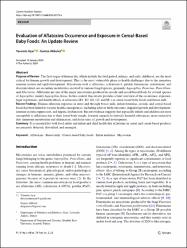Evaluation of aflatoxins occurrence and exposure in cereal-based baby foods: an update review
Künye
Açar Y, Akbulut G. Evaluation of aflatoxins occurrence and exposure in cereal-based baby foods: an update review. Current Nutrition Reports. 2024.Özet
Purpose of Review: The first stages of human life, which include the fetal period, infancy, and early childhood, are the most
critical for human growth and development. This is the most vulnerable phase to health challenges due to the immature
immune system and rapid development. Mycotoxins such as aflatoxins, ochratoxin A, patulin, fumonisins, zearalenone, and
deoxynivalenol are secondary metabolites secreted by various fungal species, primarily Aspergillus, Fusarium, Penicillium,
and Alternaria. Aflatoxins are one of the major mycotoxins produced in cereals and cereal-based foods by several species
of Aspergillus, mainly Aspergillus flavus. In this context, this review provides a brief overview of the occurrence, exposure,
legal regulations, and health effects of aflatoxins (B1, B2, G1, G2, and M1) in cereal-based baby foods and breast milk.
Recent Findings: Human aflatoxin exposure in utero and through breast milk, infant formulas, cereals, and cereal-based
foods has been linked to various health consequences, including adverse birth outcomes, impaired growth and development,
immune system suppression, and hepatic dysfunction. Recent evidence suggests that especially infants and children are more
susceptible to aflatoxins due to their lower body weight, lowered capacity to detoxify harmful substances, more restrictive
diet, immature metabolism and elimination, and faster rates of growth and development.
Summary: It is essential for both food safety and infant and child health that aflatoxins in cereal and cereal-based products
are precisely detected, detoxified, and managed.
Kaynak
Current Nutrition ReportsBağlantı
https://link.springer.com/article/10.1007/s13668-024-00519-xhttps://doi.org/10.1007/s13668-024-00519-x
https://hdl.handle.net/20.500.12780/769


















